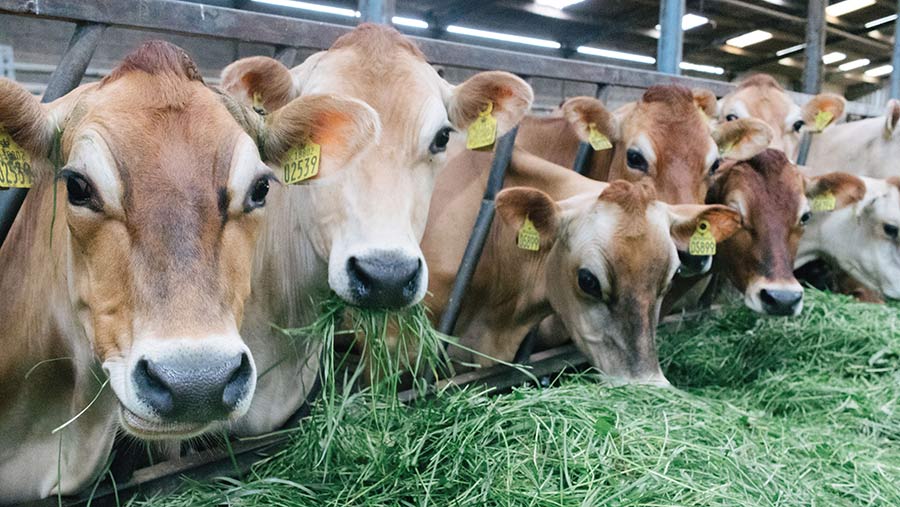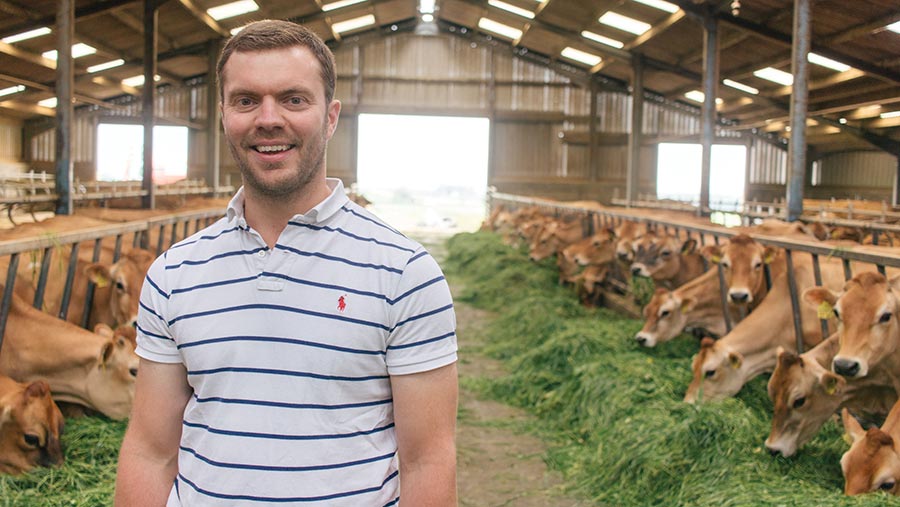9 benefits of switching to a zero-grazing system
 © Kathryn Mary Photography
© Kathryn Mary Photography Housing cows and delivering fresh grass to them daily on a zero-grazing system has helped Colin Murdoch make the most of every corner of the farm, boost milk from forage and reduce costs.
He decided to stop grazing in 2016 following concerns that heavy rainfall and grazing were having a detrimental effect on soils.
A poor milk price and the challenges of getting Holsteins to graze effectively also pushed him to think of ways to reduce costs by getting more milk from forage.
See also: Zero grazing helps dairy goat farmer to reduce concentrates
Mr Murdoch has continued to zero graze despite selling the Holstein cows two years ago and replacing them with Jerseys to make the most of a new milk contract.
Below, he lists some of the benefits.
1. Extending the grazing season
Heavy ground and high rainfall meant the grazing season used to run from early May to early September.
Zero grazing has reduced poaching risk and allowed fresh grass to be cut and carted to cows from around March to October, increasing the grazing season by three months.
Farm facts
Bunton Hill Farm, Ayrshire
- 225 Jerseys, milked twice a day
- 182ha (450 acres) total
- 6,700 litres a cow a year at 6.25% fat and 4.48% protein
- Supplying Graham’s Family Dairy
- Should achieve flat profile in the next 12 months
- Cows buffer-fed grass silage and blend in the morning
- Zero grazed in the afternoon
- Fed to yield through parlour
2. More consistent grass quality
The Holstein herd was originally set-stocked and rotated around fields, grazing a 6-8ha (15-20-acre) field for four or five days.
The same field may now be cut seven or eight times a year for zero grazing and consistently produces grass of 22-24% crude protein and 11.5-12.5 MJ/kg dry matter (DM) of metabolisable energy (ME).
3. Higher fresh grass dry matter intakes
Near-infrared spectroscopy (NIR) analysis has shown the DM of fresh grass stays relatively consistent, never falling below 17% or going above 22-23%. This is helped by always trying to cut grass in the afternoon.
When the Holsteins were grazed and buffer fed, they achieved about 12 litres a head a day from grass.

© Kathryn Mary Photography
On zero grazing, they consumed 95kg freshweight of grass a head a day and produced 18 litres a head from grass.
In September, the Jerseys ate 46kg fresh weight of zero-grazed grass a head. This helps milk from forage, which averages 56% of total milk production.
4. Reduced feed costs
Switching the Holsteins to zero grazing initially cut feed costs from 11.5p/litre to 8p/litre, largely due to higher protein levels in fresh grass, which allowed the protein in the blend and parlour concentrate to be reduced.
The Jerseys are buffer-fed in the morning to ensure they receive sufficient energy and to help rumen health.
Purchased feed costs stand at 9.43p/litre, with cows fed a 17.5% protein pre-mix, made up of a bought-in blend and home-grown, rolled barley. They are also fed an 18% parlour concentrate.
5. Opening up the whole farm
Zero grazing allows access to all the ground, some of which may not have been easy to graze.
Previously, the same fields would have been grazed, which did not allow flexibility for reseeding or planting barley around the main buildings.
6. Relatively quick return on investment
Mr Murdoch invested in a specialist zero-grazer machine, which consists of a mower on front of a trailer that hitches onto a 150hp tractor.
Although housing cattle for zero-grazing adds costs, he says they are easily paid for in monthly feed cost savings. “From what it saved us, it paid for itself in the first year-and-a-half.”
7. Ability to reduce grazing platform and carry more stock
Better grassland management has resulted in at least a 20% uplift in grass yields.
The “grazing” platform has been reduced from 73ha (180 acres) to 26ha (65 acres) for zero grazing, making more land available for followers.
Herd size has also increased from 180 Holsteins to 225 Jerseys, partly due to the smaller size of the Jerseys.
8. Ability to grow more home-grown feed
With less land needed for grazing, about 20% more barley is being grown. Growing more home-grown feed protects the business from market fluctuations.
The straw is used for bedding, and adding barley to the rotation prior to a grass reseeding helps build organic matter and clean up weeds.
9. More efficient use of slurry and less fertiliser use
“Our fertiliser bill is much less as we’re able to use slurry more effectively, as the cows are inside and we can place it where we want it,” says Mr Murdoch.
This equates to about a 15t/year saving in fertiliser use. About 1,500-2,000gal/acre of slurry is applied to every other zero-graze cut.
Tips for farmers looking to start zero grazing
- Do the maths – consider the added costs of housing and slurry storage from housing year-round
- Introduce fresh grass slowly through a total mixed ration (TMR) and reduce it gradually to avoid rumen upset
- If you’re combining fresh grass in a TMR, a tub mixer tends to handle it better than a paddle mixer
- Are your sheds set up to allow zero-grazed grass to be fed? Feeding into a trough may be a challenge and manoeuvring may be difficult in tight yards
- Choose the right leys – a leafy, thick mix is easier to work with. Mr Murdoch chooses late-maturing, diploid perennial ryegrasses with white clover
- Cut grass in the afternoon when it is drier and sugars are higher
